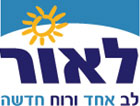communities
The Chevra Kehilatit (community of similarly disposed members)
The Chevra Kehilatit enables the citizen to fulfill his personal as well as communal obligations, and lends substance to the community's aspirations. Any significant number of citizens pursuing legitimate goals can establish a community. Citizens may combine on regional, ideological or social grounds. Regional authorities will handle sanitation, ecology and security etc.; non -regional -- cultural, educational and religious matters. The central authorities will merely inspect the quality, fairness and integrity of such services. Education will be administered by communal authorities operating on a regional or ideological basis, in accordance with the opinion of the parents.
The government will outline the basic educational, cultural and national principles of the school system, as well as supervising the administrative and sanitary standards of each institution. It will handle projects exceeding the communal bodies' capacity, and disband institutions pursuing illegitimate ends. Any significant part of the public can submit special requests to the government, citizens being free to utilize either government or communal services.
Government officials serving in educational, cultural, and welfare institutions, will now function under the communal and local authorities. This will deepen their commitment towards the public, and possibly allow the proficient to qualify for national leadership.
These reforms should be affected progressively after suitable training. Citizens controlling their own educational institutions as well as determining their environment's cultural priorities will eventually transform Israel into a community-based country in both constitutional and administrative terms.
The authorities must ensure law and order, to prevent increasing freedom of choice from turning into anarchy, the population's protection from any kind of violence being the government's prime responsibility.

